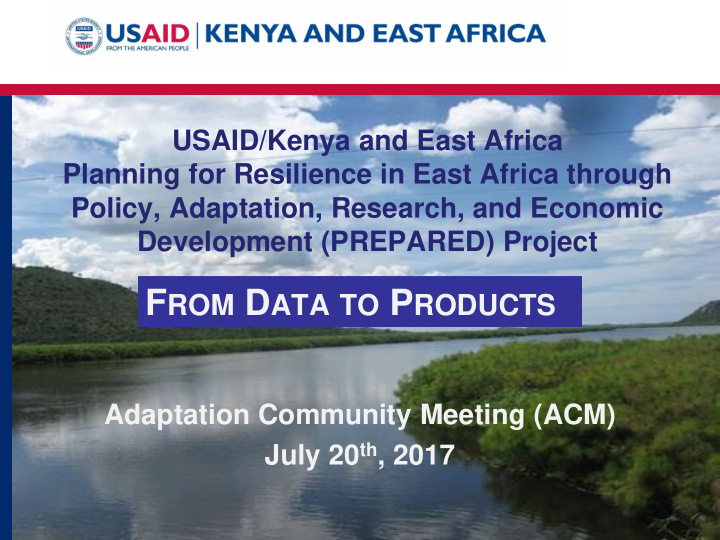



USAID/Kenya and East Africa Planning for Resilience in East Africa through Policy, Adaptation, Research, and Economic Development (PREPARED) Project F ROM D ATA TO P RODUCTS Adaptation Community Meeting (ACM) July 20 th , 2017
R EGIONAL USAID P ROGRAMS ❖ Support and work through regional organizations ❖ Promote best practices and innovations ❖ Harmonize regional policies, protocols, practices, and tools in support of transboundary (e.g. climate change adaptation) ❖ Build capacity of regional institutions to deliver on their mandates ❖ Complement bilateral and multilateral programs
C LIMATE C HANGE A DAPTATION ❖ Mainstream climate change adaptation strategies – conduct Vulnerability, Impacts and Adaptation Assessment (VIA) in Lake Victoria Basin (LVB CC Adaptation Strategy and Action Plan) ❖ Improve access to and sharing of climate change information ❖ Support the growth of the EAC Climate Change Coordination Unit (CCCU) ❖ Improve access to and future management of adaptation funds – Regional Implementing Entity (RIE) accreditation for the EAC Secretariat
Improving Access to Climate Information
I MPROVE C LIMATE I NFORMATION M ANAGEMENT ❖ Conducted Climate Information User Assessment ❖ Assessed Service Providers’ Products ❖ Facilitated Strategic Action Planning Workshop (April 2015) that provided framework for regional Climate Information Network (CIN) ❖ Establishing a CIN or User Interface ❖ Implementing Quality Service Improvement Plan (QSIP) for service providers ❖ Develop a Climate Information Management System and Clearinghouse – EAC IKMS portal
Regional Climate Information Network (CIN)
Improving Climate Services and Products ❖ Develop, test, train and use Climate Information Tools – GeoCLIM, VI Mapping, GeoMOD, GeoWRSI for real problems ❖ Developing IKM Portal for Climate Information for EAC ❖ Assisted Tanzania Meteorological Agency (TMA) capture and digitize records from 12 temperature stations and 90 rainfall stations for over 30 years records within the Tanzania portion of the Lake Victoria Basin (14,530 records) ❖ Piloting Quality Service Improvement Program (QSIP) with Kenya Meteorological Department, ICPAC, and RCMRD
Climate Information Services and Products
W HAT IS G EO CLIM? Station CHIRPs Data C limate H azards I nfra- Smart R ed Interpolation P recipitation With s tations Blended/gridded rainfall
I NTRODUCING G EO CLIM ❖ ICPAC Training Team was developed and trained ❖ 5 Partner States trained in 150 GeoCLIM and contributed station 25 data to build gridded datasets (35 35 year database) 26 ❖ Merged regional GeoCLIM gridded 15 dataset built and housed at ICPAC ❖ Working with Regional WMO office and ICPAC to support GeoCLIM and integrate with CLIMSOFT ❖ Using GeoCLIM for Weather Index Crop Insurance pilot in Kenya
CHIRPS Driven- Decision-Support-Tools support analysis and inform policies in the EAC region GeoCLIM GeoCOF GeoMOD VI Mapping GeoWRSI Statistical forecasting & Basic crop “Statistical tool “ Geospatial tool Climate data- Interpretation modeling tool for that allows for that assists visualization and tools that allows crop monitoring, downscaling technical teams and analysis tool for for automated forecasting and future climate stakeholder identify scenarios sector – specific “seasonal “agricultural risk vulnerabilities ” “climate risk forecasts & Early mapping” “ downscaled mapping” Warning with future climate “geospatial improved spatial change scenario ” vulnerability scale ” mapping”
Long-rains Short-rains Annual Rainfall Variability
Using GeoCLIM for Rainfall Trends for 35 year period for Rufiji River Basin: USAID/Tanzania WARIDI and Ministry of Water and Irrigation
No. Vulnerability Factor Possible Indicator Applying VI Mapping for Component i. Annual rainfall 1 Exposure Rainfall Ecosystem Analyses variability (CV) i. Occurrence (frequency) of drought and floods over the years Temperature i. Monthly min & max temperature i. CV for min & max i. LULC dynamic 2 Sensitivity LULC i. NDVI dynamic NDVI Human i. Population dynamic population i. Level of protection Animal (NP, GCA, NR, GR, population FR) ii. Wild animal & Livestock population dynamics i. Slope (%) Topography i. Fire frequency and Fire intensity 3 Adaptive capacity Protected areas i. Conservation status (conservancies, wildlife management areas, community based conservation development) i. Presence/absence of LUP LUPs
TMA R ESCUED S TATIONS
Quality Service Improvement Program (QSIP) Service Validate Improvement Customer Vision and Service Service Recommendat Service Values Audit Improve- ions, Action Training ment Planning & Monitoring
Government of Kenya Area Yield Crop Insurance Program 1800 1600 Reference average yield 1400 Coverage level at 80% of average yield 1200 Yield (kg per hectare) 1000 Yield shortfall to be compensated 800 by insurance payout 600 400 200 0 Crop season with no payout Crop season with payout
Government of Kenya Area Yield Index Crop Insurance Program Partner Key roles & responsibility ✓ MOALF/GOK Development of policy and institutional frameworks ✓ Develop criteria for targeting farmers ✓ Develop a system for data management ✓ Provide premium support • Farmers Register for coverage • Procure insurance premium • Insurers Develop and distribute insurance products • File products with IRA for approval • Pay claims to insured • Arrange reinsurance ✓ IRA Approve product ✓ Training and consumer education ✓ Coordinate certification training • Banks Offer credit linked to insurance • Assist in insurance product distribution ✓ Sell inputs – both subsidized and non-subsidized Agro-dealers ✓ Sell insurance linked to inputs for inputs subsidized programme
Average WRSI Start of Rainfall Season Rainfall Climatological Aridity Trends Zones
Determining Unit Areas of Insurance (UAI) MAM Rainfall Trends Agro-Ecological Unit Areas of Zones Insurance
Selected stations per Pilot County
From Data to Products Generally, value added products and services more useful than station data Products and services must be based on user demands and incentives Need reliable data coverage for precipitation and temperature – gridded data sets Users need to be ensured of data validity and credibility Credibility comes from authorized and trusted meteorological organization
PREPARED Facebook page: htts://www.facebook.com/PREPAREDProject PREPARED Twitter account: htts://www.twitter.com/PREPARED_EA www.rcmrd.org www.fews.net www.icpac.net Asanteni www.eac.int
Recommend
More recommend